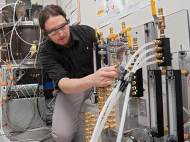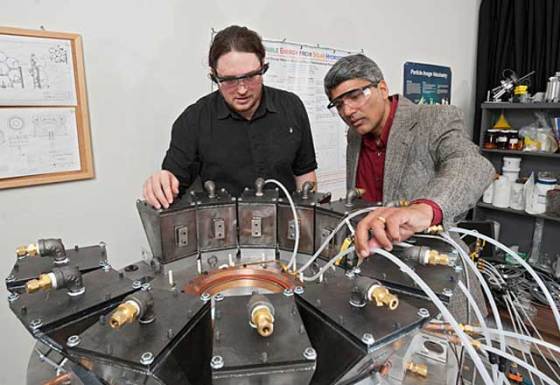Using sunlight and zinc oxide in hydrogen production
 Current traditional methods used to produce hydrogen rely on natural gas which releases carbon dioxide during conversion. There are alternative ways that are yet to be improved, such as MIT’s Artificial Leaf and other artificial photosynthesis systems, and researchers from University of Delaware (UD) came up with a different approach by designing a reactor that employs highly concentrated sunlight and zinc oxide powder to produce solar hydrogen with zero emissions.
Current traditional methods used to produce hydrogen rely on natural gas which releases carbon dioxide during conversion. There are alternative ways that are yet to be improved, such as MIT’s Artificial Leaf and other artificial photosynthesis systems, and researchers from University of Delaware (UD) came up with a different approach by designing a reactor that employs highly concentrated sunlight and zinc oxide powder to produce solar hydrogen with zero emissions.
Designed by Erik Koepf, a doctoral candidate at UD’s Department of Mechanical Engineering, the reactor measures roughly 60 cm by 90 cm (2 feet by 3 feet) and weighs a bit over 790 kg (1,750 pounds). It weights that much because it is comprised of layers of advanced, ultra-high temperature insulation and ceramic materials.
The conical geometry of the reactor’ design uses gravity to feed zinc oxide powder (the reactant) into the system through 15 hoppers perched on top of the device using special gears and a custom built control assembly Koepf developed at UD. Cooling blocks embedded in the structure are used to cool down the motors, a quartz window and the aperture ring, where the sunlight enters.
While it has been proven that reactor is able to produce hydrogen, the tests where they measure prototype’s effectiveness is performed at the Swiss Federal Institute of Technology in Zurich where its six weeks of testing started at the 5th of April 5. The concentrated light is expected to provide a temperature of over 3,000 degrees Fahrenheit, and it will be used to decompose the zinc oxide powder into pure zinc vapor. In a subsequent step, the zinc will be reacted with water to produce solar hydrogen.
“Essentially, we take zinc oxide powder and thermochemically store the energy of the sun in it, then bottle it”, said Koepf. “Zinc in and of itself is a very valuable fuel that can be used in batteries and fuel cells, among other things, even if you don’t create hydrogen.”
Koepf calls his research a “potentially sustainable energy path for the future” and he is working to patent his design through the University’s Office of Economic Innovation and Partnerships (OEIP). One interesting feature of the reactor is that, in theory, the zinc oxide byproduct created during the reaction will be re-usable, making the project self-sustaining.
“Doctoral students typically specialize in one area, but Erik’s reactor involves many different branches of mechanical engineering; notably fluid mechanics, heat transfer, reaction kinetics and experimental design”, said Ajay Prasad, professor of mechanical engineering and director of UD’s Center for Fuel Cell Research who advised Koeph during the development of the reactor. “If he is successful, one day, we can imagine a huge array of mirrors out in the desert concentrating sunlight up into a large central tower containing a larger version of Erik’s reactor and making hydrogen on an industrial scale.”










Leave your response!